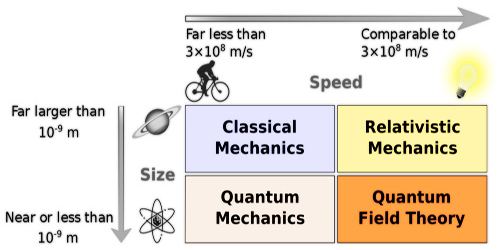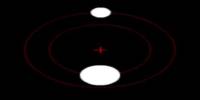Classical Physics is generally concerned with matter and energy on the normal scale of observation, while much of modern physics is concerned with the behavior of matter and energy under extreme conditions or on a very large or very small scale. For example, atomic and nuclear physics studies matter on the smallest scale at which chemical elements can be identified. The physics of elementary particles is on an even smaller scale since it is concerned with the most basic units of matter; this branch of physics is also known as high-energy physics because of the extremely high energies necessary to produce many types of particles in particle accelerators. On this scale, ordinary, commonsense notions of space, time, matter, and energy are no longer valid.
As such, the definition of a classical theory depends on the context. Classical physical concepts are often used when modern theories are unnecessarily complex for a particular situation. Most usually classical physics refers to pre-1900 physics, while modern physics refers to post-1900 physics which incorporates elements of quantum mechanics and relativity.
The two chief theories of modern physics present a different picture of the concepts of space, time, and matter from that presented by classical physics. Classical mechanics approximates nature as continuous, while quantum theory is concerned with the discrete nature of many phenomena at the atomic and subatomic level and with the complementary aspects of particles and waves in the description of such phenomena.
The theory of relativity is concerned with the description of phenomena that take place in a frame of reference that is in motion with respect to an observer; the special theory of relativity is concerned with motion in the absence of gravitational fields and the general theory of relativity with motion and its connection with gravitation. Both quantum theory and the theory of relativity find applications in all areas of modern physics.
Classical theory has at least two distinct meanings in physics. In the context of quantum mechanics, classical theory refers to theories of physics that do not use the quantization paradigm, which includes classical mechanics and relativity. Likewise, classical field theories, such as general relativity and classical electromagnetism, are those that do not use quantum mechanics. In the context of general and special relativity, classical theories are those that obey Galilean relativity. Depending on point of view, among the branches of theory sometimes included in classical physics are variable:
- Classical mechanics
- Newton’s laws of motion
- Classical Lagrangian and Hamiltonian formalisms
- Classical electrodynamics (Maxwell’s Equations)
- Classical thermodynamics
- Special relativity and general relativity
- Classical chaos theory and nonlinear dynamics
Difference Between Classical and Modern Physics: Classical physics is based on the study of macroparticles (macro means large scale) and modern physics deals with the microparticles (micro means microscopic level).
Here are give some difference between classical and modern physics –
- Waves and particles are always quite different things, over and against the idea that all things have both a wave and a particle nature.
- The matter is continuous and is composed of various essences, while there are no atoms as such so that different materials are made of different mixtures of essences, over and against the idea that different materials are made up of specific combinations of about 100 different discrete types of atoms, having very specific properties.
- Heat is a fluid. A given body contains a given quantity of heat, and heat is a conserved quantity, it is something like a fluid that can be transferred from one place to another, over and against which stands the subtle idea that temperature is an integrating factor for heat transfer, which yields entropy, which is actually a real function of the state of a macroscopic body.
- There is no maximum speed in the universe, over and against the idea that there is a maximum speed in the universe, the speed of light in vacuum, and nothing ever travels faster than that speed.
- There is a preferred frame in the universe called “absolute space”, over and against the idea that there is no preferred frame, that the laws of physics stated correctly, should not depend at all on the frame of reference.
Considering the timelines and physicists, Classical Physics marks the periods and works of Nicholas Copernicus, Johannes Kepler, Galileo Galilei, Isaac Newton, and James Maxwell. Similarly, Modern Physics marks the periods and works of Max Planck, Albert Einstein, Werner Heisenberg, Erwin Schrödinger, and Paul Dirac.
Physics uses mathematics to organize and formulate experimental results. From those results, precise or estimated solutions are obtained, quantitative results from which new predictions can be made and experimentally confirmed or negated. The results from physics experiments are numerical data, with their units of measure and estimates of the errors in the measurements. Technologies based on mathematics, like computation, have made computational physics an active area of research.
Applied physics is a general term for physics research which is intended for a particular use. An applied physics curriculum usually contains a few classes in an applied discipline, like geology or electrical engineering. It usually differs from engineering in that an applied physicist may not be designing something in particular, but rather is using physics or conducting physics research with the aim of developing new technologies or solving a problem. The approach is similar to that of applied mathematics. Applied physicists use physics in scientific research. For instance, people working on accelerator physics might seek to build better particle detectors for research in theoretical physics.
Computer modeling is essential for quantum and relativistic physics. Classic physics is considered the limit of quantum mechanics for a large number of particles. On the other hand, classic mechanics is derived from relativistic mechanics. For example, in many formulations from special relativity, a correction factor (v/c)2 appears, where v is the velocity of the object and c is the speed of light. For velocities much smaller than that of light, one can neglect the terms with c2 and higher that appear. These formulas then reduce to the standard definitions of Newtonian kinetic energy and momentum. This is as it should be, for special relativity must agree with Newtonian mechanics at low velocities. Computer modeling has to be as real as possible. Classical physics would introduce an error as in the superfluidity case. In order to produce reliable models of the world, one cannot use classic physics. It is true that quantum theories consume time and computer resources, and the equations of classical physics could be resorted to provide a quick solution, but such a solution would lack reliability.
Physics is used heavily in engineering. For example, statics, a subfield of mechanics, is used in the building of bridges and other static structures. The understanding and use of acoustics results in sound control and better concert halls; similarly, the use of optics creates better optical devices. An understanding of physics makes for more realistic flight simulators, video games, and movies, and is often critical in forensic investigations.
In a computer model, there is no need to use the speed of the object if classical physics is excluded. Low energy objects would be handled by quantum theory and high energy objects by relativity theory.
















